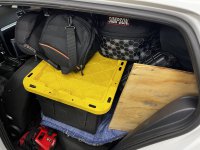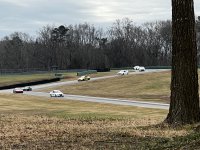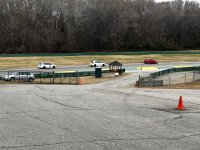7
You are using an out of date browser. It may not display this or other websites correctly.
You should upgrade or use an alternative browser.
You should upgrade or use an alternative browser.
DerHase's 2019 GTI Rabbit Edition: HPDE shenanigans
- Thread starter DerHase
- Start date
DerHase
Autocross Champion
- Location
- Hampton Roads, VA
- Car(s)
- 2019 GTI Rabbit
Just watched your video. Funny thing is, I have those brakes! Thanks again for a great time.
Any time!
Few more random pics from the weekend. Packed a ton of stuff in the GTI and even had room for the wife with 6 wheels/tires inside. A friends’s son just got his permit so I let him take my car out for parade laps. Not too many 15yo kids can say they’ve driven 110mph at VIR
Attachments
19birel
Autocross Champion
- Location
- Pittsburgh
- Car(s)
- MK7.5 - MK4 - B8.5
Looks like you guys had a blast! Bummed I couldn't make it!
DerHase
Autocross Champion
- Location
- Hampton Roads, VA
- Car(s)
- 2019 GTI Rabbit
Full trip report is here:
https://www.datadrivenmqb.com/tripreports/vir-with-tscc-december-2023

@Redslaya found 9 miles per hour(!) on the back straight with his duct no longer letting the hot oil cooler air heat soak his intercooler. We already proved it worked at Palmer earlier this year, but now that we were back at VIR it was wild to test it on the same track and see real tangible results in a properly designed solution.
https://www.datadrivenmqb.com/drivetrain/oil-cooler-duct-conclusionresults
I had a ton of fun driving in the rain on Sunday:
And the photographer got a video where you can clearly see the high and low temperature difference where air is being extracted from the hood vent which is super neat:
https://www.youtube.com/shorts/thTkDF3Qb8c

https://www.datadrivenmqb.com/tripreports/vir-with-tscc-december-2023
@Redslaya found 9 miles per hour(!) on the back straight with his duct no longer letting the hot oil cooler air heat soak his intercooler. We already proved it worked at Palmer earlier this year, but now that we were back at VIR it was wild to test it on the same track and see real tangible results in a properly designed solution.
https://www.datadrivenmqb.com/drivetrain/oil-cooler-duct-conclusionresults
I had a ton of fun driving in the rain on Sunday:
And the photographer got a video where you can clearly see the high and low temperature difference where air is being extracted from the hood vent which is super neat:
https://www.youtube.com/shorts/thTkDF3Qb8c
DerHase
Autocross Champion
- Location
- Hampton Roads, VA
- Car(s)
- 2019 GTI Rabbit
So some goodies have been ordered:
- APR lowering springs
- BFI LCA bushings (because the ones I installed a year ago are already starting to tear/separate)
- I also accidentally bought an IS38. One in confirmed good used condition came up for sale for a price I couldn't resist.
One in confirmed good used condition came up for sale for a price I couldn't resist.

And I'm sitting on some stuff that was purchased over the last year:
- Audi aluminum subframe
- the 034 lower ball joints, I took them off after they made the car handle goofy at stock ride height... so going to give them a more fair shake once the car is lowered.
- Superpro poly forward LCA bushings. These will be going back on at the same time as the 034 LBJs, because the Powerflex offset ones creak like a SOB, and I don't think there is enough travel/plunge on my axle shafts to not cause problems due to extending too far outward if used in combination with the ball joints as well.
I really doubt I'll be installing the turbo before the February HPDE. I'm still really wanting to knock down a 2:10 on the IS20 at VIR... though I'll settle for a 2:11. If I can hit at least a 2:11 in February, then I'll swap it out between then and May (barring disaster).
And then because of all the PCV testing stuff I'm doing, I ordered a (third) MK8 PCV... to replace the one I drilled holes in (which will further get cut up eventually for science). I have the MK8 PCV sensor fitted now:
https://www.datadrivenmqb.com/drivetrain/mk8pcvsensor
And also did some testing of with vs without Venturi... which will get used to compare what happens when we swap turbo inlet pipes out as well:
https://www.datadrivenmqb.com/drivetrain/venturicrankcasetesting
- APR lowering springs
- BFI LCA bushings (because the ones I installed a year ago are already starting to tear/separate)
- I also accidentally bought an IS38.
And I'm sitting on some stuff that was purchased over the last year:
- Audi aluminum subframe
- the 034 lower ball joints, I took them off after they made the car handle goofy at stock ride height... so going to give them a more fair shake once the car is lowered.
- Superpro poly forward LCA bushings. These will be going back on at the same time as the 034 LBJs, because the Powerflex offset ones creak like a SOB, and I don't think there is enough travel/plunge on my axle shafts to not cause problems due to extending too far outward if used in combination with the ball joints as well.
I really doubt I'll be installing the turbo before the February HPDE. I'm still really wanting to knock down a 2:10 on the IS20 at VIR... though I'll settle for a 2:11. If I can hit at least a 2:11 in February, then I'll swap it out between then and May (barring disaster).
And then because of all the PCV testing stuff I'm doing, I ordered a (third) MK8 PCV... to replace the one I drilled holes in (which will further get cut up eventually for science). I have the MK8 PCV sensor fitted now:
https://www.datadrivenmqb.com/drivetrain/mk8pcvsensor
And also did some testing of with vs without Venturi... which will get used to compare what happens when we swap turbo inlet pipes out as well:
https://www.datadrivenmqb.com/drivetrain/venturicrankcasetesting
mrmatto
Autocross Champion
- Location
- Jacksonville, FL
- Car(s)
- 2024 GTI DSG
Will be interesting to see how how the Koni SA’s do with lowering springs.
What led you to choose the APR springs?
What led you to choose the APR springs?
DerHase
Autocross Champion
- Location
- Hampton Roads, VA
- Car(s)
- 2019 GTI Rabbit
Will be interesting to see how how the Koni SA’s do with lowering springs.
What led you to choose the APR springs?
They are one of the "least low" drop springs, and also one of the stiffer springs available. If more rotation is needed, I can try upping the rear to 400 or 450lbs easily (which @xXDavidCXx has done on Koni SAs before). I have some 450lb coilover springs leftover on a shelf from my Mazda2. So it should be basically free for me to test.
Estimated weight transfer with OEM springs:
Estimated w/ APR springs (which includes a wild ass guess of dropping the ride height/sprung COG about 1in, and roll center up front dropping about double that, with the rear not quite as much due to the multi link suspension (roll center doesn't drop at the same rate as a Mcstrut front):
The above rough calcs don't take into account doing the roll center correction ball joints as well... which ASSuming they restore the roll center back to the estimated stock height, will actually make the car tend back towards understeer on paper:
In reality, I think they will add more grip, because we all know the car needs camber. More camber up front = more grip = more weight transfer.
These charts are all modeled in steady state, but where the benefit of raised roll center (when the car actually could use it... not at stock height) might come into play is under heavy trail braking... the car won't dive on the inside front as hard (compared to the same lowered ride height withOUT the ball joints... and in theory-land the same amount of camber too) because the change in roll center is effectively adding geometric roll stiffness.
I like to think of it as geometric stiffness because if you were to put the control arm at the right angle (aimed directly at the center of gravity, mid turn)... all of the sideways forces are trying to go through a straight and non-flexible control arm.
If the control arm is angled WAY downwards (at the knuckle)... your roll center is super high. Think control arms at like 45 deg []/ \[] ... If this happens you get a "jacking" effect and in a hard corner the COG is going to try and move the inner pickup of the LCA towards the tire... and flop right over.
If the control arm is angled WAY upwards (at the knuckle)... your roll center is super low (this happens when lowered excessively). []\ /[] ... With it like this, the control arm is acting just as a hinge, and closer to 100% of the forces from COG are going straight towards compressing the spring.
Somewhere in there is a happy medium.
And on top of that, you also need to worry about F vs R roll centers... they combine to give you the roll axis inclination. If they're severely mismatched, the whole car can have a tendency to teeter forwards or backwards even in a constant 1.2g turn with zero fore/aft input.
I'm giving these ball joints one last shot (and planning to measure the full range of motion for bump steer without a spring installed)... though I don't have high hopes. I suspect they'll chew outside edges of the tires due to bump steer, though I hope I'm wrong.
mrmatto
Autocross Champion
- Location
- Jacksonville, FL
- Car(s)
- 2024 GTI DSG
Oh wow are you sure you thought this through? /s
Amazing work. I hope it dials it in for you.
Amazing work. I hope it dials it in for you.
19birel
Autocross Champion
- Location
- Pittsburgh
- Car(s)
- MK7.5 - MK4 - B8.5
Accidentally ordered a turbo? Man I hate when that happens the GTI is really going to be ready to party this coming season! You'll probably make it to the track before I do this year so I'll be interested to hear your impressions of the lowering springs paired with the SAs.
the GTI is really going to be ready to party this coming season! You'll probably make it to the track before I do this year so I'll be interested to hear your impressions of the lowering springs paired with the SAs.
xXDavidCXx
Autocross Champion
- Location
- AZ
- Car(s)
- 2017 GTI SE DSG
Overall observations from my many rear spring changes (OEM through 1000 in/lbs)They are one of the "least low" drop springs, and also one of the stiffer springs available. If more rotation is needed, I can try upping the rear to 400 or 450lbs easily (which @xXDavidCXx has done on Koni SAs before). I have some 450lb coilover springs leftover on a shelf from my Mazda2. So it should be basically free for me to test.
Estimated weight transfer with OEM springs:
View attachment 297419
Estimated w/ APR springs (which includes a wild ass guess of dropping the ride height/sprung COG about 1in, and roll center up front dropping about double that, with the rear not quite as much due to the multi link suspension (roll center doesn't drop at the same rate as a Mcstrut front):
View attachment 297421
The above rough calcs don't take into account doing the roll center correction ball joints as well... which ASSuming they restore the roll center back to the estimated stock height, will actually make the car tend back towards understeer on paper:
View attachment 297422
In reality, I think they will add more grip, because we all know the car needs camber. More camber up front = more grip = more weight transfer.
These charts are all modeled in steady state, but where the benefit of raised roll center (when the car actually could use it... not at stock height) might come into play is under heavy trail braking... the car won't dive on the inside front as hard (compared to the same lowered ride height withOUT the ball joints... and in theory-land the same amount of camber too) because the change in roll center is effectively adding geometric roll stiffness.
I like to think of it as geometric stiffness because if you were to put the control arm at the right angle (aimed directly at the center of gravity, mid turn)... all of the sideways forces are trying to go through a straight and non-flexible control arm.
If the control arm is angled WAY downwards (at the knuckle)... your roll center is super high. Think control arms at like 45 deg []/ \[] ... If this happens you get a "jacking" effect and in a hard corner the COG is going to try and move the inner pickup of the LCA towards the tire... and flop right over.
If the control arm is angled WAY upwards (at the knuckle)... your roll center is super low (this happens when lowered excessively). []\ /[] ... With it like this, the control arm is acting just as a hinge, and closer to 100% of the forces from COG are going straight towards compressing the spring.
Somewhere in there is a happy medium.
And on top of that, you also need to worry about F vs R roll centers... they combine to give you the roll axis inclination. If they're severely mismatched, the whole car can have a tendency to teeter forwards or backwards even in a constant 1.2g turn with zero fore/aft input.
I'm giving these ball joints one last shot (and planning to measure the full range of motion for bump steer without a spring installed)... though I don't have high hopes. I suspect they'll chew outside edges of the tires due to bump steer, though I hope I'm wrong.
Rear spring changes made very little difference on rear rotation.
The only thing that for sure affected rear rotation was rear toe-out.
DerHase
Autocross Champion
- Location
- Hampton Roads, VA
- Car(s)
- 2019 GTI Rabbit
Overall observations from my many rear spring changes (OEM through 1000 in/lbs)
Rear spring changes made very little difference on rear rotation.
The only thing that for sure affected rear rotation was rear toe-out.
Gotcha. My guess is it'll be similar to my Mazda2: more rear rate was necessary to help put power down out of corners, not so much for corner entry.
19birel
Autocross Champion
- Location
- Pittsburgh
- Car(s)
- MK7.5 - MK4 - B8.5
I've been meaning to ask, what are your thoughts on teh V730s now that you've been running on them for a while? I remember you not being too found of them initially, curious if you were planning to stick with them or switch it up for the coming season
DerHase
Autocross Champion
- Location
- Hampton Roads, VA
- Car(s)
- 2019 GTI Rabbit
I've been meaning to ask, what are your thoughts on teh V730s now that you've been running on them for a while? I remember you not being too found of them initially, curious if you were planning to stick with them or switch it up for the coming season
Oh hey. Not sure how I missed this 3 months ago... hah.
I think they're a great dry tire. Last a long time, tolerate "not enough" camber, and don't get insanely greasy. The very first event they will SUCK. So if you're only doing track days I'd go and do an autocross just to scrub the tires in so you don't waste a $500+ weekend on track hating them.
Absolutely suck in the rain no matter what you do though.
I MIGHT buy another set for track use. I have some RE71RS for autocross, and honestly might just buy another set of the same tires for track use on my other set of 17x9s. They're REALLY damn good. Definitely won't be lasting near as long as the V730s though.
When I'm instructing I'm much more likely to go out for 2-4 laps at a time and then come in, rather than run full 20-25 min long sessions, so the tires lasting forever is a bit less of a concern for me now IMO.
DerHase
Autocross Champion
- Location
- Hampton Roads, VA
- Car(s)
- 2019 GTI Rabbit
First autocross of the year trip report is up:
https://www.datadrivenmqb.com/tripreports/2024tsccax1

https://www.datadrivenmqb.com/tripreports/2024tsccax1
00Zero
Go Kart Newbie
- Location
- Pittsburgh, Pa
@DerHase just curious if you would share your total cog, front cog and roll center heights from that worksheet?They are one of the "least low" drop springs, and also one of the stiffer springs available. If more rotation is needed, I can try upping the rear to 400 or 450lbs easily (which @xXDavidCXx has done on Koni SAs before). I have some 450lb coilover springs leftover on a shelf from my Mazda2. So it should be basically free for me to test.
Estimated weight transfer with OEM springs:
View attachment 297419
Estimated w/ APR springs (which includes a wild ass guess of dropping the ride height/sprung COG about 1in, and roll center up front dropping about double that, with the rear not quite as much due to the multi link suspension (roll center doesn't drop at the same rate as a Mcstrut front):
View attachment 297421
The above rough calcs don't take into account doing the roll center correction ball joints as well... which ASSuming they restore the roll center back to the estimated stock height, will actually make the car tend back towards understeer on paper:
View attachment 297422
In reality, I think they will add more grip, because we all know the car needs camber. More camber up front = more grip = more weight transfer.
These charts are all modeled in steady state, but where the benefit of raised roll center (when the car actually could use it... not at stock height) might come into play is under heavy trail braking... the car won't dive on the inside front as hard (compared to the same lowered ride height withOUT the ball joints... and in theory-land the same amount of camber too) because the change in roll center is effectively adding geometric roll stiffness.
I like to think of it as geometric stiffness because if you were to put the control arm at the right angle (aimed directly at the center of gravity, mid turn)... all of the sideways forces are trying to go through a straight and non-flexible control arm.
If the control arm is angled WAY downwards (at the knuckle)... your roll center is super high. Think control arms at like 45 deg []/ \[] ... If this happens you get a "jacking" effect and in a hard corner the COG is going to try and move the inner pickup of the LCA towards the tire... and flop right over.
If the control arm is angled WAY upwards (at the knuckle)... your roll center is super low (this happens when lowered excessively). []\ /[] ... With it like this, the control arm is acting just as a hinge, and closer to 100% of the forces from COG are going straight towards compressing the spring.
Somewhere in there is a happy medium.
And on top of that, you also need to worry about F vs R roll centers... they combine to give you the roll axis inclination. If they're severely mismatched, the whole car can have a tendency to teeter forwards or backwards even in a constant 1.2g turn with zero fore/aft input.
I'm giving these ball joints one last shot (and planning to measure the full range of motion for bump steer without a spring installed)... though I don't have high hopes. I suspect they'll chew outside edges of the tires due to bump steer, though I hope I'm wrong.




